engine JEEP RENEGADE 2018 Owner handbook (in English)
[x] Cancel search | Manufacturer: JEEP, Model Year: 2018, Model line: RENEGADE, Model: JEEP RENEGADE 2018Pages: 356, PDF Size: 6.11 MB
Page 211 of 356
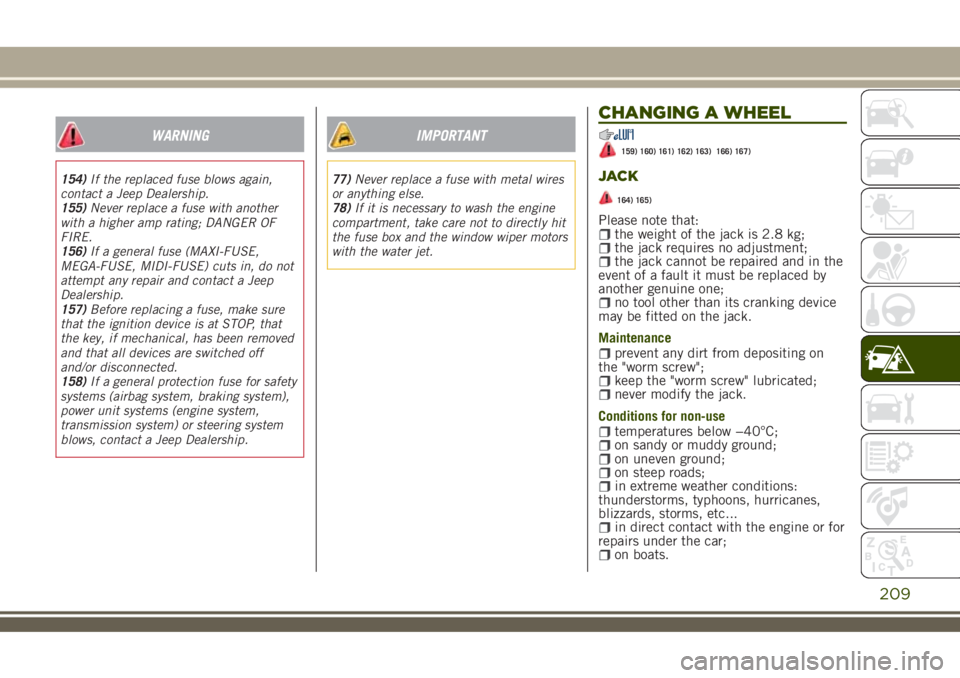
WARNING
154)If the replaced fuse blows again,
contact a Jeep Dealership.
155)Never replace a fuse with another
with a higher amp rating; DANGER OF
FIRE.
156)If a general fuse (MAXI-FUSE,
MEGA-FUSE, MIDI-FUSE) cuts in, do not
attempt any repair and contact a Jeep
Dealership.
157)Before replacing a fuse, make sure
that the ignition device is at STOP, that
the key, if mechanical, has been removed
and that all devices are switched off
and/or disconnected.
158)If a general protection fuse for safety
systems (airbag system, braking system),
power unit systems (engine system,
transmission system) or steering system
blows, contact a Jeep Dealership.
IMPORTANT
77)Never replace a fuse with metal wires
or anything else.
78)If it is necessary to wash the engine
compartment, take care not to directly hit
the fuse box and the window wiper motors
with the water jet.
CHANGING A WHEEL
159) 160) 161) 162) 163) 166) 167)
JACK
164) 165)
Please note that:the weight of the jack is 2.8 kg;the jack requires no adjustment;the jack cannot be repaired and in the
event of a fault it must be replaced by
another genuine one;
no tool other than its cranking device
may be fitted on the jack.
Maintenance
prevent any dirt from depositing on
the "worm screw";
keep the "worm screw" lubricated;never modify the jack.
Conditions for non-use
temperatures below −40°C;on sandy or muddy ground;on uneven ground;on steep roads;in extreme weather conditions:
thunderstorms, typhoons, hurricanes,
blizzards, storms, etc...
in direct contact with the engine or for
repairs under the car;
on boats.
209
Page 212 of 356
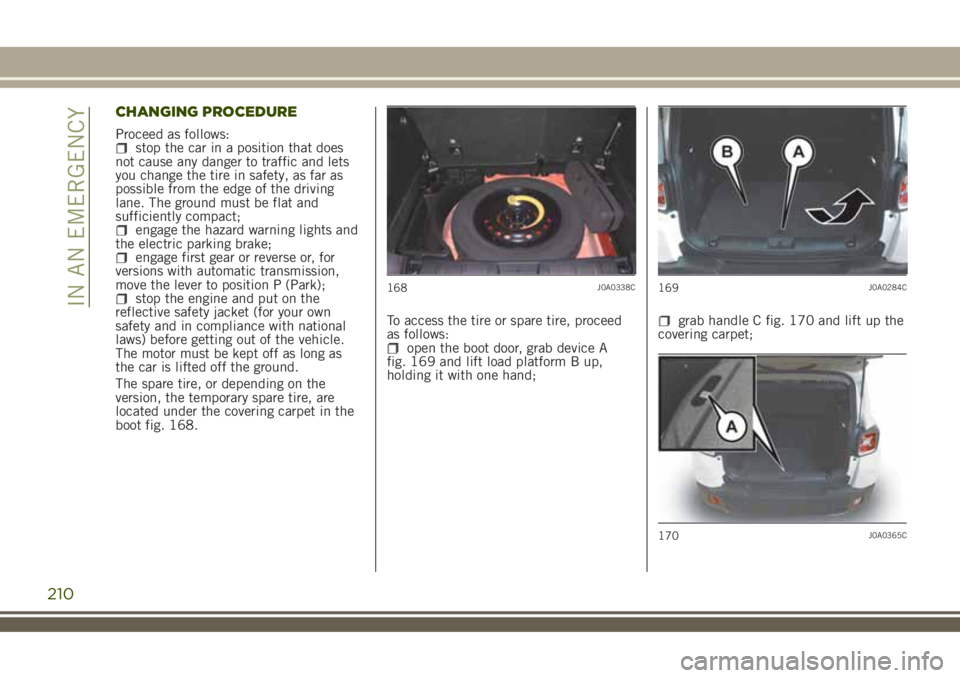
CHANGING PROCEDURE
Proceed as follows:stop the car in a position that does
not cause any danger to traffic and lets
you change the tire in safety, as far as
possible from the edge of the driving
lane. The ground must be flat and
sufficiently compact;
engage the hazard warning lights and
the electric parking brake;
engage first gear or reverse or, for
versions with automatic transmission,
move the lever to position P (Park);
stop the engine and put on the
reflective safety jacket (for your own
safety and in compliance with national
laws) before getting out of the vehicle.
The motor must be kept off as long as
the car is lifted off the ground.
The spare tire, or depending on the
version, the temporary spare tire, are
located under the covering carpet in the
boot fig. 168.To access the tire or spare tire, proceed
as follows:
open the boot door, grab device A
fig. 169 and lift load platform B up,
holding it with one hand;
grab handle C fig. 170 and lift up the
covering carpet;
168J0A0338C169J0A0284C
170J0A0365C
210
IN AN EMERGENCY
Page 216 of 356
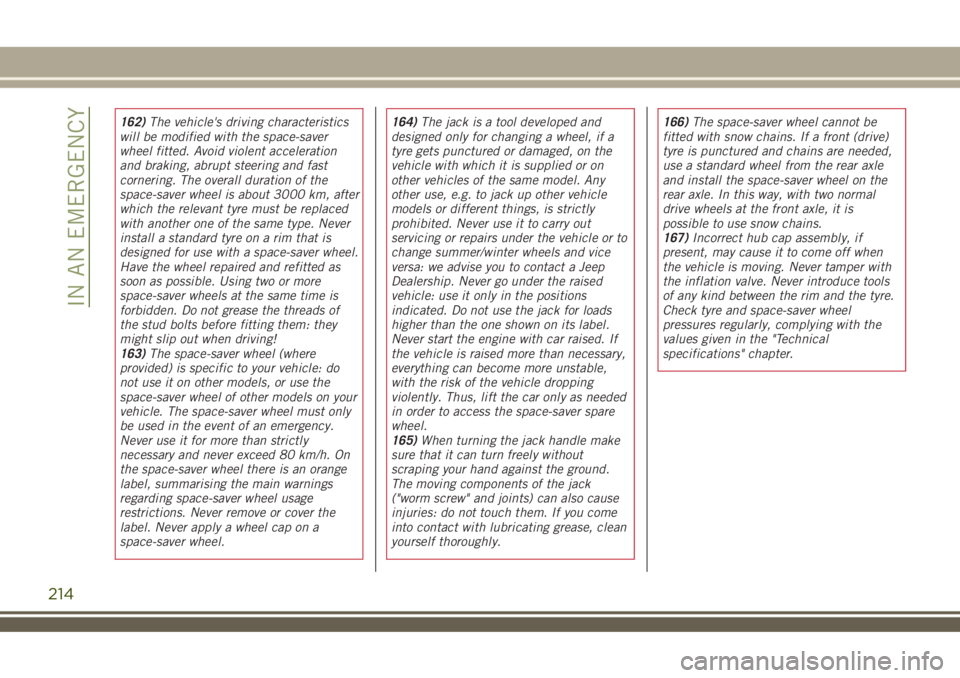
214
IN AN EMERGENCY
162)The vehicle's driving characteristics
will be modified with the space-saver
wheel fitted. Avoid violent acceleration
and braking, abrupt steering and fast
cornering. The overall duration of the
space-saver wheel is about 3000 km, after
which the relevant tyre must be replaced
with another one of the same type. Never
install a standard tyre on a rim that is
designed for use with a space-saver wheel.
Have the wheel repaired and refitted as
soon as possible. Using two or more
space-saver wheels at the same time is
forbidden. Do not grease the threads of
the stud bolts before fitting them: they
might slip out when driving!
163)The space-saver wheel (where
provided) is specific to your vehicle: do
not use it on other models, or use the
space-saver wheel of other models on your
vehicle. The space-saver wheel must only
be used in the event of an emergency.
Never use it for more than strictly
necessary and never exceed 80 km/h. On
the space-saver wheel there is an orange
label, summarising the main warnings
regarding space-saver wheel usage
restrictions. Never remove or cover the
label. Never apply a wheel cap on a
space-saver wheel.164)The jack is a tool developed and
designed only for changing a wheel, if a
tyre gets punctured or damaged, on the
vehicle with which it is supplied or on
other vehicles of the same model. Any
other use, e.g. to jack up other vehicle
models or different things, is strictly
prohibited. Never use it to carry out
servicing or repairs under the vehicle or to
change summer/winter wheels and vice
versa: we advise you to contact a Jeep
Dealership. Never go under the raised
vehicle: use it only in the positions
indicated. Do not use the jack for loads
higher than the one shown on its label.
Never start the engine with car raised. If
the vehicle is raised more than necessary,
everything can become more unstable,
with the risk of the vehicle dropping
violently. Thus, lift the car only as needed
in order to access the space-saver spare
wheel.
165)When turning the jack handle make
sure that it can turn freely without
scraping your hand against the ground.
The moving components of the jack
("worm screw" and joints) can also cause
injuries: do not touch them. If you come
into contact with lubricating grease, clean
yourself thoroughly.166)The space-saver wheel cannot be
fitted with snow chains. If a front (drive)
tyre is punctured and chains are needed,
use a standard wheel from the rear axle
and install the space-saver wheel on the
rear axle. In this way, with two normal
drive wheels at the front axle, it is
possible to use snow chains.
167)Incorrect hub cap assembly, if
present, may cause it to come off when
the vehicle is moving. Never tamper with
the inflation valve. Never introduce tools
of any kind between the rim and the tyre.
Check tyre and space-saver wheel
pressures regularly, complying with the
values given in the "Technical
specifications" chapter.
Page 217 of 356

TIREKIT
(where provided)
DESCRIPTION
168) 169)
79)
3)
The TireKit is located in the luggage
compartment inside its own box. The
container is also equipped with a
screwdriver, the tow ring and the
refuelling adaptor.
LPG versions
The car has a “TireKit” quick tyre repair
kit, not a space-saver spare wheel,
located in the boot inside a specific rigid
preformed housing fig. 176.The TireKit fig. 177 comprises:
one cartridge A containing sealant and
fitted with: transparent tube for injecting
the sealant and sticker C with the
wording MAX 80 km/h / 50 mph to be
placed in a clearly visible position (e.g.
on the dashboard) after repairing the
tyre;
one compressor B;one leaflet containing instructions for
using the kit;
a pair of gloves located in the hose
compartment of the cartridge D.
REPAIR PROCEDURE
Proceed as follows:stop the car in a position that is not
dangerous for oncoming traffic where you
can change the wheel safely. The car
must be stopped in a lay-by, car-park or
parking or service area, and the ground
must be as level as possible and
sufficiently compact;
switch off the engine, apply the
electrical parking brake and engage the
1st gear or reverse gear. Make sure that
any passengers get out of the car and go
to a safe place where they will not
obstruct traffic or be exposed to the risk
of injury. Wear the reflective safety jacket
(compulsory by law) before getting out of
the car;
176J0A0947C177J0A0955C
215
Page 218 of 356
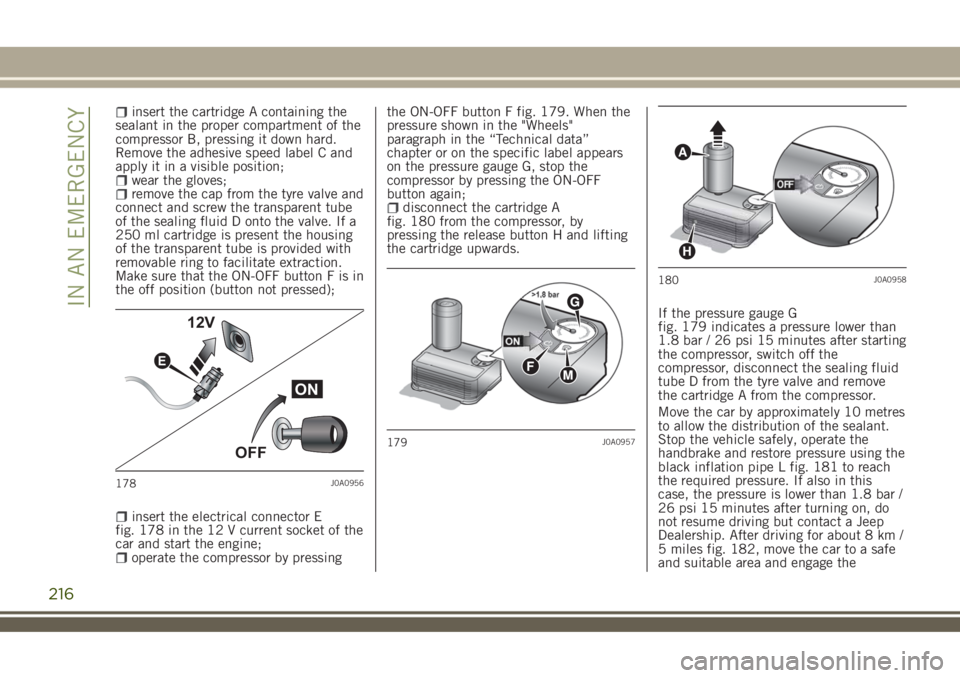
insert the cartridge A containing the
sealant in the proper compartment of the
compressor B, pressing it down hard.
Remove the adhesive speed label C and
apply it in a visible position;
wear the gloves;remove the cap from the tyre valve and
connect and screw the transparent tube
of the sealing fluid D onto the valve. If a
250 ml cartridge is present the housing
of the transparent tube is provided with
removable ring to facilitate extraction.
Make sure that the ON-OFF button F is in
the off position (button not pressed);
insert the electrical connector E
fig. 178 in the 12 V current socket of the
car and start the engine;
operate the compressor by pressingthe ON-OFF button F fig. 179. When the
pressure shown in the "Wheels"
paragraph in the “Technical data”
chapter or on the specific label appears
on the pressure gauge G, stop the
compressor by pressing the ON-OFF
button again;
disconnect the cartridge A
fig. 180 from the compressor, by
pressing the release button H and lifting
the cartridge upwards.
If the pressure gauge G
fig. 179 indicates a pressure lower than
1.8 bar / 26 psi 15 minutes after starting
the compressor, switch off the
compressor, disconnect the sealing fluid
tube D from the tyre valve and remove
the cartridge A from the compressor.
Move the car by approximately 10 metres
to allow the distribution of the sealant.
Stop the vehicle safely, operate the
handbrake and restore pressure using the
black inflation pipe L fig. 181 to reach
the required pressure. If also in this
case, the pressure is lower than 1.8 bar /
26 psi 15 minutes after turning on, do
not resume driving but contact a Jeep
Dealership. After driving for about 8 km /
5 miles fig. 182, move the car to a safe
and suitable area and engage the
ON
OFF 12V
E
178J0A0956
179J0A0957
A
H
180J0A0958
216
IN AN EMERGENCY
Page 221 of 356
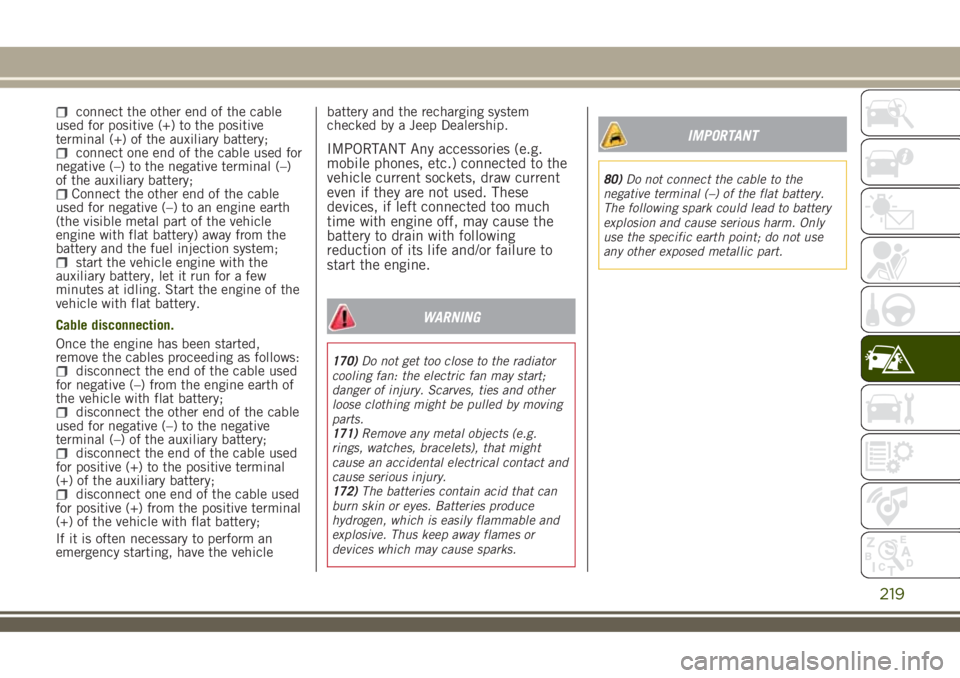
connect the other end of the cable
used for positive (+) to the positive
terminal (+) of the auxiliary battery;
connect one end of the cable used for
negative (–) to the negative terminal (–)
of the auxiliary battery;
Connect the other end of the cable
used for negative (–) to an engine earth
(the visible metal part of the vehicle
engine with flat battery) away from the
battery and the fuel injection system;
start the vehicle engine with the
auxiliary battery, let it run for a few
minutes at idling. Start the engine of the
vehicle with flat battery.
Cable disconnection.
Once the engine has been started,
remove the cables proceeding as follows:
disconnect the end of the cable used
for negative (–) from the engine earth of
the vehicle with flat battery;
disconnect the other end of the cable
used for negative (–) to the negative
terminal (–) of the auxiliary battery;
disconnect the end of the cable used
for positive (+) to the positive terminal
(+) of the auxiliary battery;
disconnect one end of the cable used
for positive (+) from the positive terminal
(+) of the vehicle with flat battery;
If it is often necessary to perform an
emergency starting, have the vehiclebattery and the recharging system
checked by a Jeep Dealership.
IMPORTANT Any accessories (e.g.
mobile phones, etc.) connected to the
vehicle current sockets, draw current
even if they are not used. These
devices, if left connected too much
time with engine off, may cause the
battery to drain with following
reduction of its life and/or failure to
start the engine.
WARNING
170)Do not get too close to the radiator
cooling fan: the electric fan may start;
danger of injury. Scarves, ties and other
loose clothing might be pulled by moving
parts.
171)Remove any metal objects (e.g.
rings, watches, bracelets), that might
cause an accidental electrical contact and
cause serious injury.
172)The batteries contain acid that can
burn skin or eyes. Batteries produce
hydrogen, which is easily flammable and
explosive. Thus keep away flames or
devices which may cause sparks.
IMPORTANT
80)Do not connect the cable to the
negative terminal (–) of the flat battery.
The following spark could lead to battery
explosion and cause serious harm. Only
use the specific earth point; do not use
any other exposed metallic part.
219
Page 222 of 356
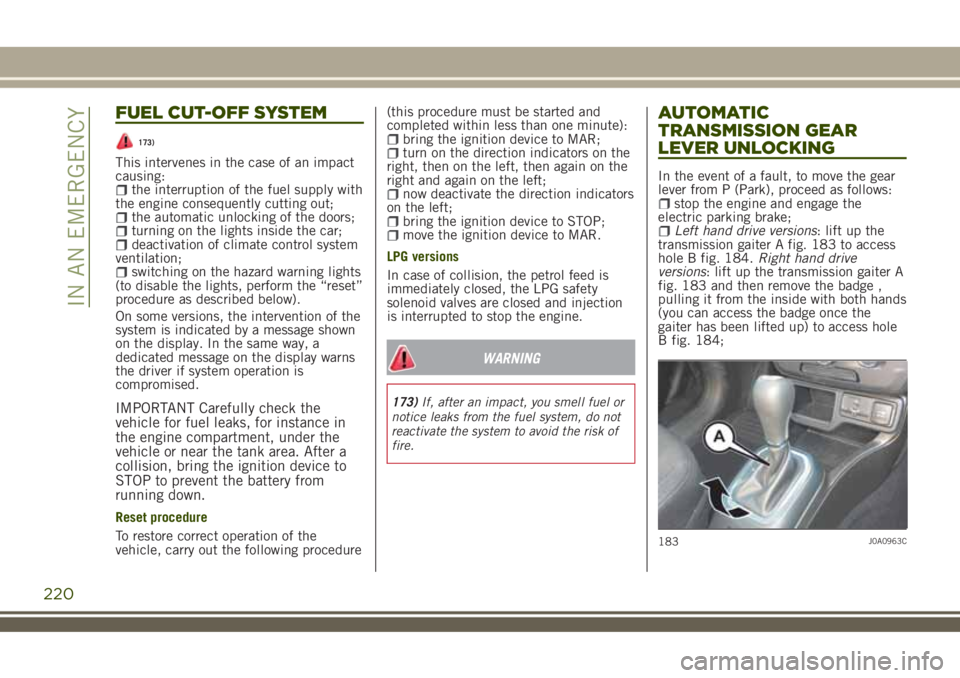
FUEL CUT-OFF SYSTEM
173)
This intervenes in the case of an impact
causing:
the interruption of the fuel supply with
the engine consequently cutting out;
the automatic unlocking of the doors;turning on the lights inside the car;deactivation of climate control system
ventilation;
switching on the hazard warning lights
(to disable the lights, perform the “reset”
procedure as described below).
On some versions, the intervention of the
system is indicated by a message shown
on the display. In the same way, a
dedicated message on the display warns
the driver if system operation is
compromised.
IMPORTANT Carefully check the
vehicle for fuel leaks, for instance in
the engine compartment, under the
vehicle or near the tank area. After a
collision, bring the ignition device to
STOP to prevent the battery from
running down.
Reset procedure
To restore correct operation of the
vehicle, carry out the following procedure(this procedure must be started and
completed within less than one minute):
bring the ignition device to MAR;turn on the direction indicators on the
right, then on the left, then again on the
right and again on the left;
now deactivate the direction indicators
on the left;
bring the ignition device to STOP;move the ignition device to MAR.
LPG versions
In case of collision, the petrol feed is
immediately closed, the LPG safety
solenoid valves are closed and injection
is interrupted to stop the engine.
WARNING
173)If, after an impact, you smell fuel or
notice leaks from the fuel system, do not
reactivate the system to avoid the risk of
fire.
AUTOMATIC
TRANSMISSION GEAR
LEVER UNLOCKING
In the event of a fault, to move the gear
lever from P (Park), proceed as follows:
stop the engine and engage the
electric parking brake;
Left hand drive versions: lift up the
transmission gaiter A fig. 183 to access
hole B fig. 184.Right hand drive
versions: lift up the transmission gaiter A
fig. 183 and then remove the badge ,
pulling it from the inside with both hands
(you can access the badge once the
gaiter has been lifted up) to access hole
B fig. 184;
183J0A0963C
220
IN AN EMERGENCY
Page 223 of 356
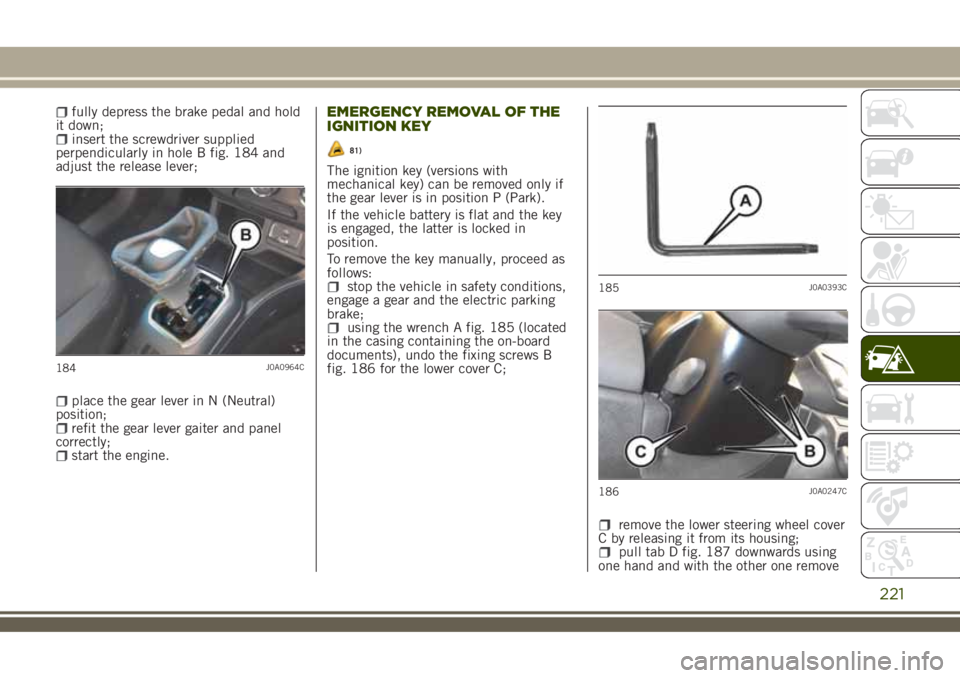
fully depress the brake pedal and hold
it down;
insert the screwdriver supplied
perpendicularly in hole B fig. 184 and
adjust the release lever;
place the gear lever in N (Neutral)
position;
refit the gear lever gaiter and panel
correctly;
start the engine.
EMERGENCY REMOVAL OF THE
IGNITION KEY
81)
The ignition key (versions with
mechanical key) can be removed only if
the gear lever is in position P (Park).
If the vehicle battery is flat and the key
is engaged, the latter is locked in
position.
To remove the key manually, proceed as
follows:
stop the vehicle in safety conditions,
engage a gear and the electric parking
brake;
using the wrench A fig. 185 (located
in the casing containing the on-board
documents), undo the fixing screws B
fig. 186 for the lower cover C;
remove the lower steering wheel cover
C by releasing it from its housing;
pull tab D fig. 187 downwards using
one hand and with the other one remove
184J0A0964C
185J0A0393C
186J0A0247C
221
Page 224 of 356
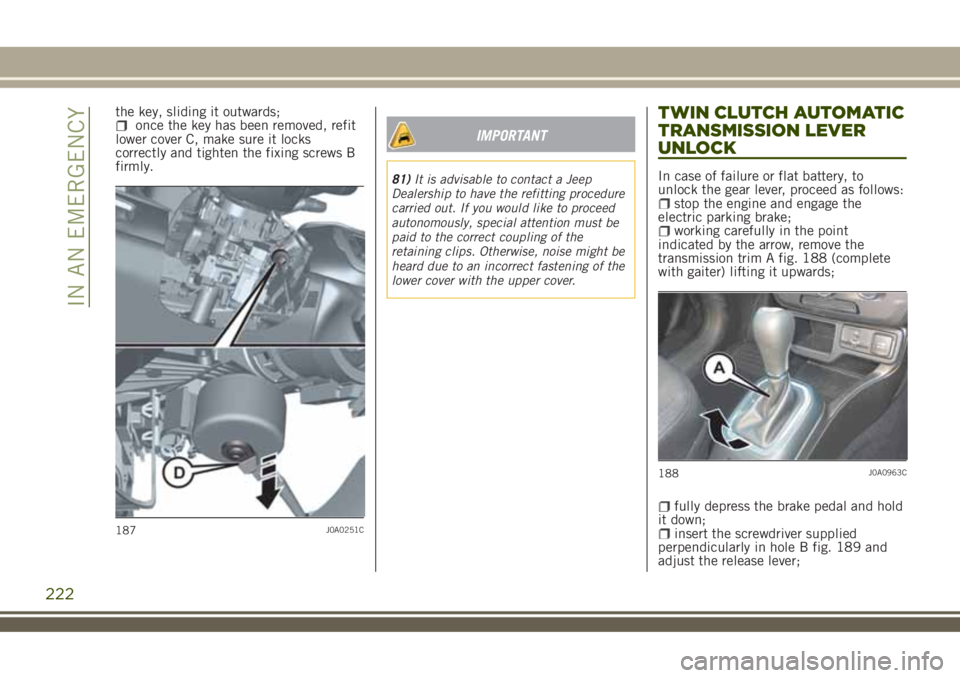
the key, sliding it outwards;once the key has been removed, refit
lower cover C, make sure it locks
correctly and tighten the fixing screws B
firmly.IMPORTANT
81)It is advisable to contact a Jeep
Dealership to have the refitting procedure
carried out. If you would like to proceed
autonomously, special attention must be
paid to the correct coupling of the
retaining clips. Otherwise, noise might be
heard due to an incorrect fastening of the
lower cover with the upper cover.
TWIN CLUTCH AUTOMATIC
TRANSMISSION LEVER
UNLOCK
In case of failure or flat battery, to
unlock the gear lever, proceed as follows:
stop the engine and engage the
electric parking brake;
working carefully in the point
indicated by the arrow, remove the
transmission trim A fig. 188 (complete
with gaiter) lifting it upwards;
fully depress the brake pedal and hold
it down;
insert the screwdriver supplied
perpendicularly in hole B fig. 189 and
adjust the release lever;187J0A0251C
188J0A0963C
222
IN AN EMERGENCY
Page 225 of 356
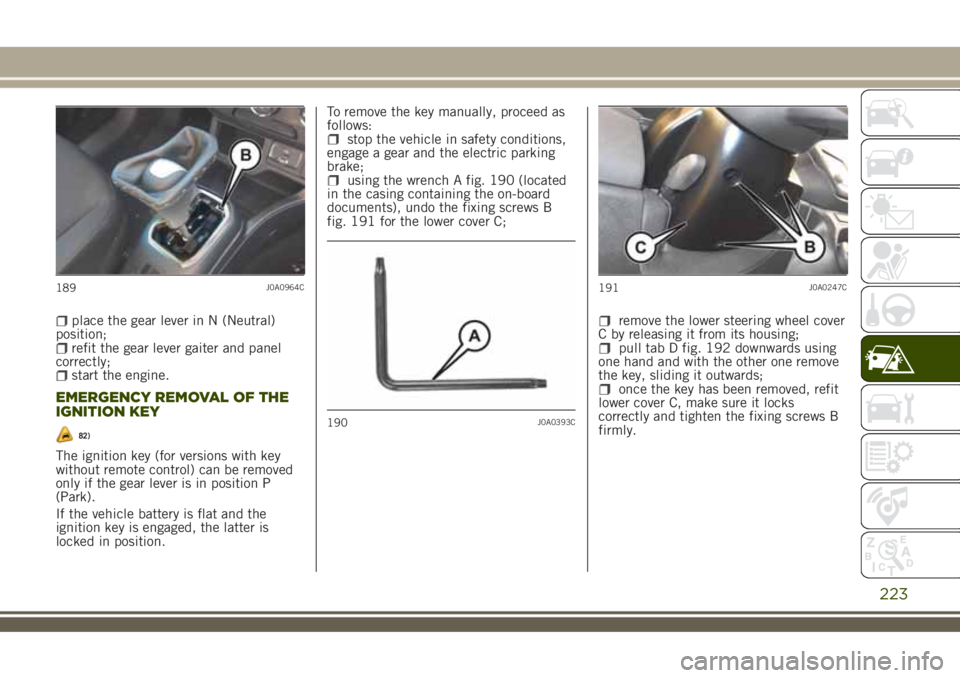
place the gear lever in N (Neutral)
position;
refit the gear lever gaiter and panel
correctly;
start the engine.
EMERGENCY REMOVAL OF THE
IGNITION KEY
82)
The ignition key (for versions with key
without remote control) can be removed
only if the gear lever is in position P
(Park).
If the vehicle battery is flat and the
ignition key is engaged, the latter is
locked in position.To remove the key manually, proceed as
follows:
stop the vehicle in safety conditions,
engage a gear and the electric parking
brake;
using the wrench A fig. 190 (located
in the casing containing the on-board
documents), undo the fixing screws B
fig. 191 for the lower cover C;
remove the lower steering wheel cover
C by releasing it from its housing;
pull tab D fig. 192 downwards using
one hand and with the other one remove
the key, sliding it outwards;
once the key has been removed, refit
lower cover C, make sure it locks
correctly and tighten the fixing screws B
firmly.
189J0A0964C
190J0A0393C
191J0A0247C
223